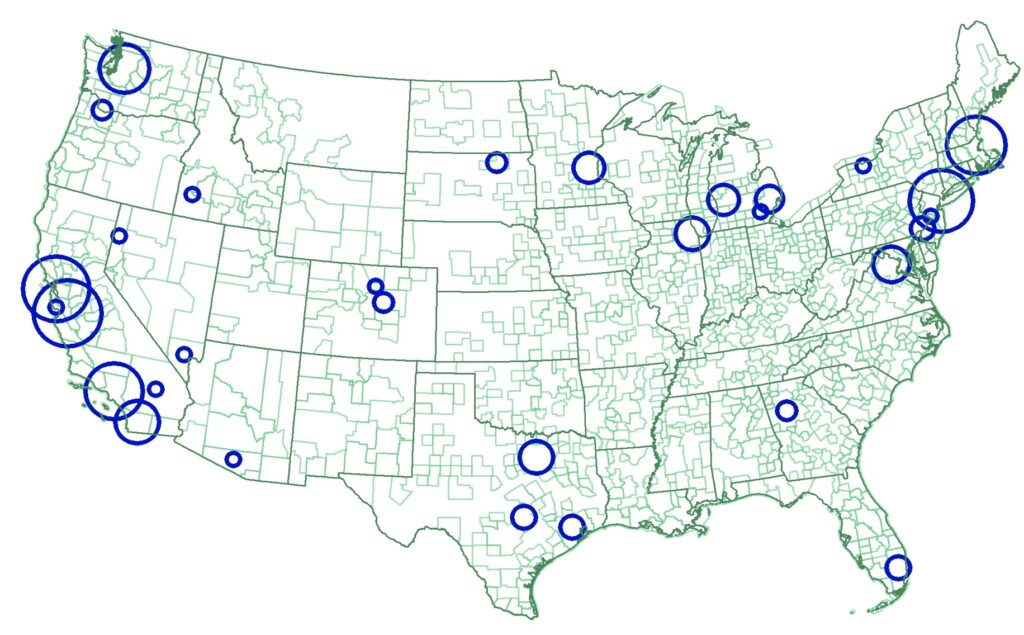What City Observatory did this week
1. Tackling climate change will require electric cars, and a lot less driving. We’re pleased to publish a guest commentary from CalYimby’s Matthew Lewis looking at the challenge of addressing the role of transportation in climate change. Electric vehicles are a step in the right direction, to be sure, but Lewis argues we’ll need to do a lot more to reduce driving if we want to make progress in reducing greenhouse gas emissions on the timetable needed to avert global catastrophe, and also to minimize all the other social, environmental and health consequences that flow from our auto-dependent development patterns and lifestyles.
2. BIB: Bad Infrastructure Bill. This week, with much fanfare about bi-partisanship, the Senate passed its version of an infrastructure bill. Transportation for America, NACTO, Streetsblog and others have offer detailed analyses of the bill, aka “BIB” or Bipartisan Infrastructure Bill. We summarize its contents in the form of four lamentations: it’s going to squander more than $200 billion, mostly on widening roads that will increase pollution, it has not accountability for actually better results, it is a massive dose of “asphalt socialism” that makes a mockery of the supposed “user pays” principle. Plus, we could have done so much better, based on legislation that passed the House. In the end, “BIB” is a fitting name for the bill, as its really the kind of legislation that would chiefly endear itself to the Michelin tire mascot:
Must read
1. America’s sprawling urban growth. Where has land development been surging across the country? Which cities have been growing fastest? This interactive Washington Post piece showcases the nation’s land development growth from 2001-2019. The biggest sprawl we’ve seen in the country has been in the South and Southwest. Maricopa County, including Phoenix, has seen the most growth since 2000 with more than 270 square miles of new development. Other Sunbelt cities, like Boise, Las Vegas, and Atlanta, have likewise recorded staggering growth. Housing affordability and availability seems to play a vital role in the inward movement of development and sprawl. Industries have been moving into the Sun Belt which has helped contribute to its sprawl. Demographic shifts also play a meaningful role. As baby boomers walk into retirement, the older population grows, which sustains the growth in Florida and the Southwest, home for many retirees. This piece offers a compelling look at America’s evolution in the new millennium. Go pick where you are from to examine the growth your hometown has seen in the last two decades.
2. Road design privileges cars. In 2012, Jeff Speck published Walkable City illustrating a range of ideas of reducing car-dependence and increasing walkability in urban areas. Over the last decade, some of these then-progressive and groundbreaking ideas have become increasingly popular. Here, Governing interviews Speck revisiting topics from his book and discussing the impact of remote work on cities. His answers explore the growth of the urban planning field, its current state, and how it can continue to improve. The polls show that people want more livable cities. In Boston, 81 percent of randomly polled individuals said they wanted to keep the street parklets put in place due to COVID and 79 percent were in favor of keeping the additional bike lanes. While the public opinion is tilting toward walkability, institutions and policies lag: Cars still control the roads. Speck explains this lack of progress,
Intellectually, and in terms of platforms you see among progressive politicians, there has been a lot of ground gained since 2012. But it’s still super hard to get these things done, as we’re seeing now with the reversion of some of these COVID-19 amenities back to the way they were before. Typically, a minority of people who speak loudly are pretty effective in overruling majority public opinion in favor of more walkable places.
Speck also discusses how road design can impact driving behavior and the livability of cities. They talk about the differences across metro areas as well as the significant effects of COVID on the roads. We may be approaching a decade since Walkable City was published, yet its core concepts remain to be important today.
3. Houston’s Freeway Fighters push back against TXDOT. Drama surrounding TxDOT’s I-45 expansion project has been rising as the public comment period draws to a close. Its plan to expand the freeway to mitigate congestion has been widely criticized by opponents arguing that expansion would worsen air quality and displace hundreds of families. Opponents have asked for a smaller, less disruptive plan that would lessen environmental damage and neighborhood dislocation. In response, TxDOT has threatened project funding: “If the project is not approved, a TxDOT spokesperson said last week that the agency could take the money and use it elsewhere.” Even though the public comment period has ended this week, the fight against TxDOT’s threat and their highway plan will continue in weeks to come.
New Knowledge
By intersecting the text from these three sources, we are able to trace mentions of disruptive innovations from their original patents to the conversations of executives and investors at large firms, and finally to job postings that advertise positions involved with using or producing these technologies. Using this approach, we are able to determine which innovations or sets of innovations (‘technologies’) affect businesses, trace these back to the locations and firms where they emerged, and track their diffusion through jobs advertised in different regions, occupations, and industries over time.



